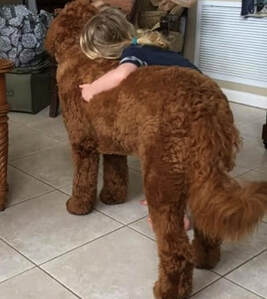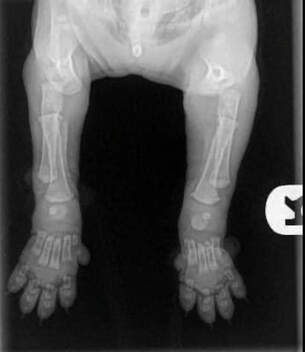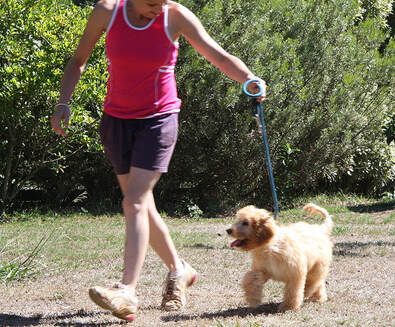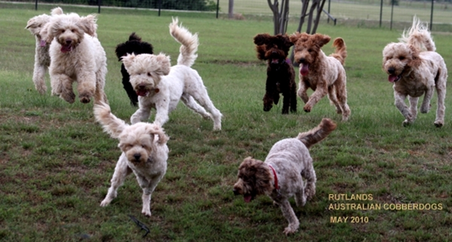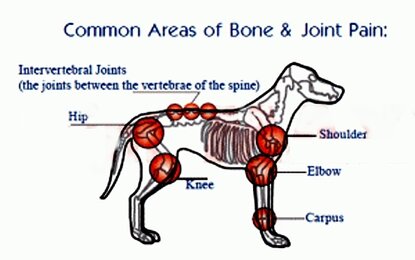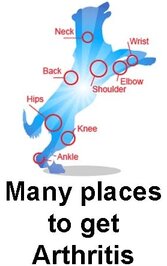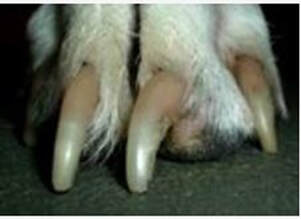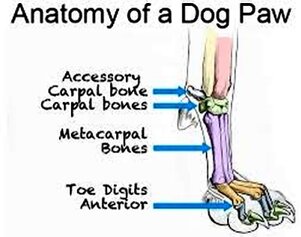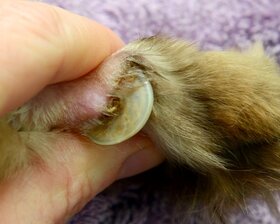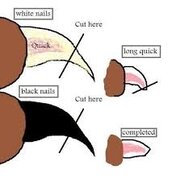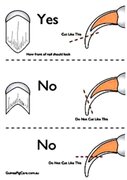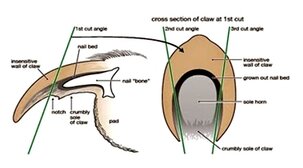Hip Dysplasia (HD) and Australian Cobberdogs. Can HD (hip dysplasia) be prevented in dogs?
The information here is provided to every puppy buyer of a Rutlands Australian Cobberdog, in the puppy raising notes that accompany every puppy sold by Rutlands Australian Cobberdogs.
Osteochondritis Dissicans (OCD) is a general term which covers HD and any problems concerning the joints. They're very painful conditions and mainly affect young, large breed dogs. But smaller dogs and older dogs can get it as well. Expert research over years at The Institute of Canine Biology has found that dysplastic dogs or puppies can be born to parents which have both been tested and graded as 'Excellent".
Environment plays a huge role in the onset of HD and breeders can only do so much. Owners need to take proper care of their immature puppies as they raise them. So what is proper care?
Environment plays a huge role in the onset of HD and breeders can only do so much. Owners need to take proper care of their immature puppies as they raise them. So what is proper care?
Can Hip Dysplasia (HD) and other OCDs in Dogs be prevented?
The Hip Dysplasia Scheme was established by BVA and the Kennel Club in 1965 and In 1983 a new system for the prediction of HD was established (Pennhip) and in 1993 the PennHIP organisation began testing puppies as young as 16 weeks old.
But don't take my word for it. The Institute of Canine Biology with world class Research scientists have been studying canine hip dysplasia (HD) for decades and are global experts on the condition. The following link takes you to their findings.
PUPPY EXERCISE - CAUTION!
Think of a puppy’s many immature bony joints as each one throughout its body being attached to its own set of baby muscles, ligaments and tendons. When puppy takes a step, these soft tissue support groups all work in together to open and close their own joint.
Their bones do not even touch yet. They plod around with big floppy paws and wobbly movement because their joints are entirely made up of muscle, tendons and ligaments with skin covering. Nothing is fitting tightly together or has a true socket yet.
Once grown you will have the rest of their life to spend playing and engaging in higher impact exercise. So keep it calm while they're still little baby puppies. When you bring your cute new puppy home remember these images of what lies hidden inside.
Once grown you will have the rest of their life to spend playing and engaging in higher impact exercise. So keep it calm while they're still little baby puppies. When you bring your cute new puppy home remember these images of what lies hidden inside.
Every jump up and down off the lounge or bed, and letting them run around on slippery floors or on beach sand can cause impacts between the bones. In reasonable amounts this is not problematic and is the normal wear and tear that every animal will engage in. But when you don't restrict the exercise of young immature dogs to stop them from overdoing it during this immature growing period you don't give them a chance to grow properly.
You only get the chance to grow them once. A well-built body starts from judicious breeding BUT it is then up to you to raise your puppy properly!
You only get the chance to grow them once. A well-built body starts from judicious breeding BUT it is then up to you to raise your puppy properly!
Mechanical Exercise
Mechanical Exercise, like on a leash, sets a repetitive action – like a machine or on a treadmill and this kind of exercise is most common for young puppies. Unfortunately, it also predisposes to repetitive strain fatigue or injury when a young immature animal is exposed to it for too long at a time, or too often.
We (when sane) would never think of expecting our toddler to accompany us on the 10 mile hike that our 18 year old teenager does with ease. When soft tissue starts to fatigue, it can no longer regulate support for the joint it’s assigned to protect. And so joint lubrication may leak, bone may scrape on bone causing cartilage damage, and the stage is being set for arthritis in the future and even hip, shoulder and elbow OCDs while still young. The following are guidelines only and will vary with the size of the puppy and the terrain. Larger sizes mature more slowly.
3 to 6 months old - suggest a maximum of 30 minutes in the one session
6 to 12 months old - suggest a maximum of 1 hour in the one session
We (when sane) would never think of expecting our toddler to accompany us on the 10 mile hike that our 18 year old teenager does with ease. When soft tissue starts to fatigue, it can no longer regulate support for the joint it’s assigned to protect. And so joint lubrication may leak, bone may scrape on bone causing cartilage damage, and the stage is being set for arthritis in the future and even hip, shoulder and elbow OCDs while still young. The following are guidelines only and will vary with the size of the puppy and the terrain. Larger sizes mature more slowly.
3 to 6 months old - suggest a maximum of 30 minutes in the one session
6 to 12 months old - suggest a maximum of 1 hour in the one session
Free Exercise
Young dogs and puppies all follow the same pattern of behavior when they're first let off the leash to go and play. And this pattern is modified only by the athleticism of their particular breed.
Watch the superb athleticism of this young Australian Cobberdog Rutlands Jesse who has been raised correctly by his owner, Dr Anke Doley in Sth Australia.
- Cobberdogs are a naturally athletic breed and they love to run. Set them free to play and after a quick sniff or two, and a slight pause to make sure you're watching, your sweet cuddly adult therapy dog will suddenly take off at the speed of light, twisting, turning in mid air to race on at breakneck speed in the opposite direction, often from a standstill. Maybe in mid flight he'll put on the brakes effortlessly to sniff something (just because he can!) before racing off again. I still feel spellbound after all these years when I watch these light footed canine fairies streak past me with such precision, seemingly without their paws touching the ground.
- Underneath this display of athletic brilliance, Nature is methodically hard at work, instinctively stretching and exercising a myriad of inner parts of the anatomy, as well as fine tuning motor skills.
- Puppies know instinctively when it's time to slow down after the first burst of excitement at being free because they quickly tire and don't push the limits the way they do when another dog is egging them on to do more.
- Notice how your puppy plays. Short burst of activity are interspersed with brief periods of rest. It might be by flopping down to roll in the grass ( which uses different groups of muscles) or lying down to chew on grass, or a stick or leaf. Compare how different it is from how his body moves when he's being taken on a leash walk.
Impact Injury or Strain and OCDs.
What are high places for young puppies?
High places for puppies are basically anything higher than their own back with all four feet on the floor/ground.
- Getting bumped in play with older heavier dogs Impact
- Over taxing immature joint supportive tissue by allowing unnatural stresses like climbing or descending stairs, leash walking in wet or dry sand, forcing them to balance on boards in pools or the ocean, riding skateboards etc.
- Letting puppies play and fetch ball on slippery surfaces like polished floors,
- jumping or leaping up or down from high places
What are high places for young puppies?
High places for puppies are basically anything higher than their own back with all four feet on the floor/ground.
Another precursor to arthritis - neglected toenails!
In nature, dogs and puppies run on a variety of surfaces in any one day; dirt, grass, pebbles, gritty gravel and rock. While they run and play, the rough surfaces make them bunch their paws which strengthens surrounding soft tissues, and bone. Nails are naturally ground down. In a domestic environment however, they spend most of their time either indoors, or outside on bowling green - smooth lawns and smooth pathways.
We only have to think how our toes feel in shoes that are too tight to understand how a dog with overgrown toenails feels 24/7. When nails get too long, pressure pushes up from the ground or floor into the sensitive nail bed. To avoid pain, the dog leans back on his ankles, which in turn stresses not only ankles, elbows and knees, but also shoulder and hip assembly although the results may not be felt until months or even years later.
We only have to think how our toes feel in shoes that are too tight to understand how a dog with overgrown toenails feels 24/7. When nails get too long, pressure pushes up from the ground or floor into the sensitive nail bed. To avoid pain, the dog leans back on his ankles, which in turn stresses not only ankles, elbows and knees, but also shoulder and hip assembly although the results may not be felt until months or even years later.
A dog's toenail grows in a sabre shape with a blood vessel running along the length of each nail. This always stays the same distance from the tip of the nail. So as the nail grows, the blood vessel travels down with it. When the nail is cut or ground the blood vessel shrinks back upwards to maintain it's consistent distance from the nail tip. Nails can't be cut from too long to just right in one session because the shrinking process takes some time.
If toenails have been allowed to get too long, a little is usually cut in sessions two weeks apart until the desired length is reached. The cut is always made just below the highest point of the arc shape of the nail so as to avoid a bleed. This place is easy to see on white nails, but with black nails the arc shape is a sure guide.
If toenails have been allowed to get too long, a little is usually cut in sessions two weeks apart until the desired length is reached. The cut is always made just below the highest point of the arc shape of the nail so as to avoid a bleed. This place is easy to see on white nails, but with black nails the arc shape is a sure guide.
